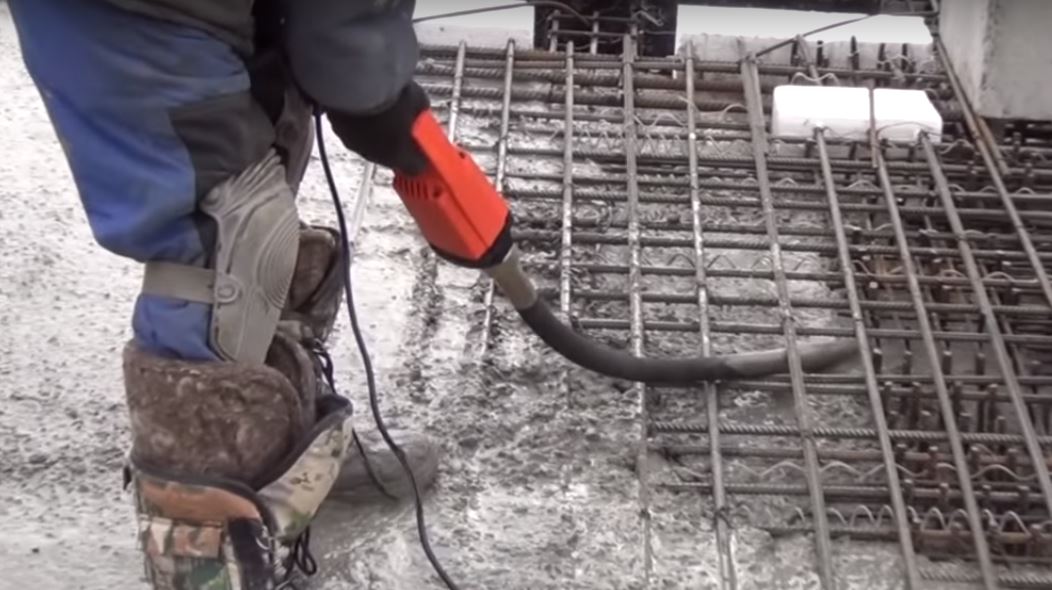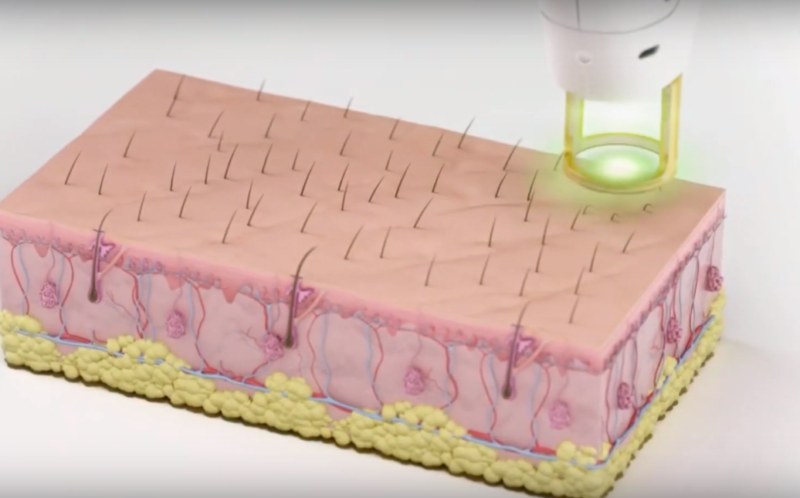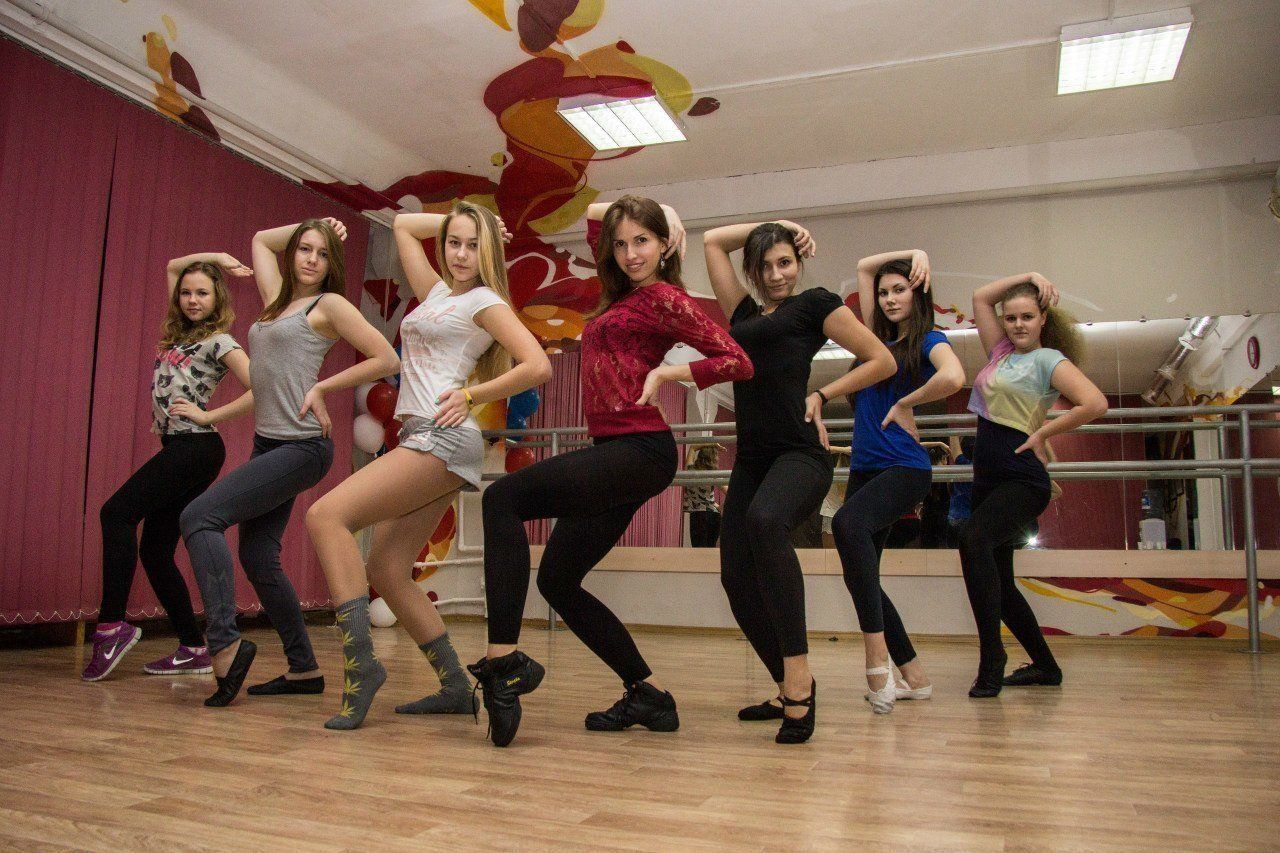Rating of the best anesthesia and respiratory devices for 2022

The coronavirus pandemic has made its own adjustments to everyday life, changing it radically: issues that previously paid little attention to came to the fore.
One of these issues is the level of equipment of health care institutions. Despite the fact that the post-Soviet healthcare system has many positive aspects, compared to the European one, it has long experienced a shortage of modern equipment, new technologies in treatment and comfortable conditions for patients. The complex of these problems led to the fact that many institutions were not ready for a new threat called “coronavirus”, since in a pandemic, an extremely important factor in the recovery of the population is the availability of a large number of beds and intensive care equipment. The main component of the second criterion is the presence of anesthetic-respiratory devices, which help a person with pneumonia to saturate the lungs with oxygen, and in the case of a coma, they completely take over the respiratory function.
In this article, we will consider the most popular models of lung ventilation devices, get acquainted with the criteria for their selection, form a rating of the best of them based on feedback from real users, and also find out what to look for in order not to make mistakes when choosing.
Content
What is an anesthesia machine for?
In medicine, an anesthetic-respiratory apparatus (NDA) is a device that delivers a mixture of gaseous anesthetics into a person’s lungs, while it forms a single complex with an artificial lung ventilation apparatus and a monitor that displays the patient’s main vital signs.
The principle of operation of the device is to supply, together with air, a gaseous anesthetic mixture into the lungs of a person, which has optimal indicators of temperature and humidity. The mechanism is designed in such a way as to remove the air mixture from the lungs with minimal human effort.
Each device of this type consists of a gas supply system and a tank for mixing and redirection. The three most commonly used gases in anesthesia machines are air, pure oxygen, and nitrous oxide.In order to prevent personnel from accidentally mixing up the supply hoses, an international marking system has been created, according to which oxygen corresponds to green, air - blue, nitrous oxide - yellow. All connectors also have matching colors and different connectors, making it impossible to mistakenly connect the wrong hose. When buying a Russian-made unit, it should be borne in mind that their hoses for oxygen and air are reverse marked (air is green, oxygen is blue).
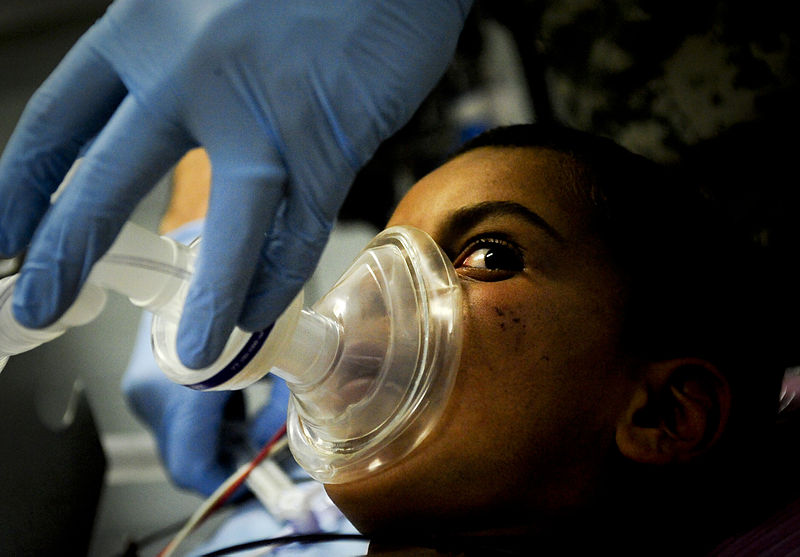
What to Consider When Buying a NDA
Most of the devices sold, both Russian and foreign, have the following characteristics:
- almost all of them are equipped with a fuse with the function of turning off the supply of nitrous oxide in the event that the mixture contains less than 30% oxygen when inhaled;
- most modern devices have a button that instantly replaces the supplied mixture with pure oxygen - a function used in emergency situations.
Criteria for choosing anesthesia and respiratory devices:
- The ability to adjust the volume of breathing. The parameter includes the minute volume of breathing and its frequency. The best devices allow you to adjust such characteristics as: the duration of the inspiratory phase, changing the ratio of the inspiratory and expiratory phase, adjusting the exhalation curve, etc.
- Ability to work in spontaneous breathing mode. Such a function is necessary in cases where the patient has spontaneous breathing (for example, during elective operations). Sometimes it is used during manual ventilation.
- Availability of an autonomous backup power supply.The function is needed for emergency use during power supply problems.
- The presence of systems for monitoring positive airway pressure or at the end of inspiration. This feature allows you to maintain respiratory function during anesthesia, which is especially important for patients with pneumonia, including those caused by coronavirus.
The principle of operation of the device is simple: from cylinders, the gas mixture is supplied through hoses to the breathing circuit. It can be of two types: direct and reverse. In the second case, the mixture of gases returns from the respiratory tract and mixes with the fresh mixture, then again entering the lungs. In such devices, an adsorber is necessarily installed, which removes carbon dioxide from the air mixture.
Depending on how the anesthetic composition is delivered through the device, the following types of breathing circuits are distinguished:
- Open - has not been practically used recently, since such mechanisms do not have the ability to adjust the level of anesthesia, as well as its depth. This type of NDA does not have an evaporator and a mixing tank.
- Semi open type. The principle of operation is designed in such a way that only fresh composition enters the patient's lungs, the exhaled air is discharged directly into the atmosphere.
- Semi closed type. In such a circuit, reverse is partially used. The volume of the mixture that is recirculated is inversely proportional to the volume of the supplied gas-air mixture. Excess gases are released into the atmosphere. With this technology, an adsorbent is necessarily used, which absorbs carbon dioxide in order to avoid its toxic effects on the human body.
- closed type.In such a circuit, complete tightness is created, an adsorbent is necessarily used, the contact of the anesthetic composition with the surrounding atmosphere does not occur.
Recently, modular devices have been on sale. The popularity of models of this type is due to the ability to modify the anesthesia and respiratory apparatus for the specific needs of a medical institution, wide functionality and scope.
NDA are produced in various versions: wall-mounted, floor-standing, portable (portable). The first are used in ambulances, the second - in hospitals, the third - by emergency rescue services in emergency situations.
Rating of high-quality anesthesia and respiratory devices
Most often, stationary models are used for large medical institutions, which have a number of advantages - a wide scope of use, design features allow you to configure the device depending on the needs of the clinic, can be used for inhalation anesthesia, mechanical ventilation, general anesthesia.
Stationary Models
Dräger Perseus A500
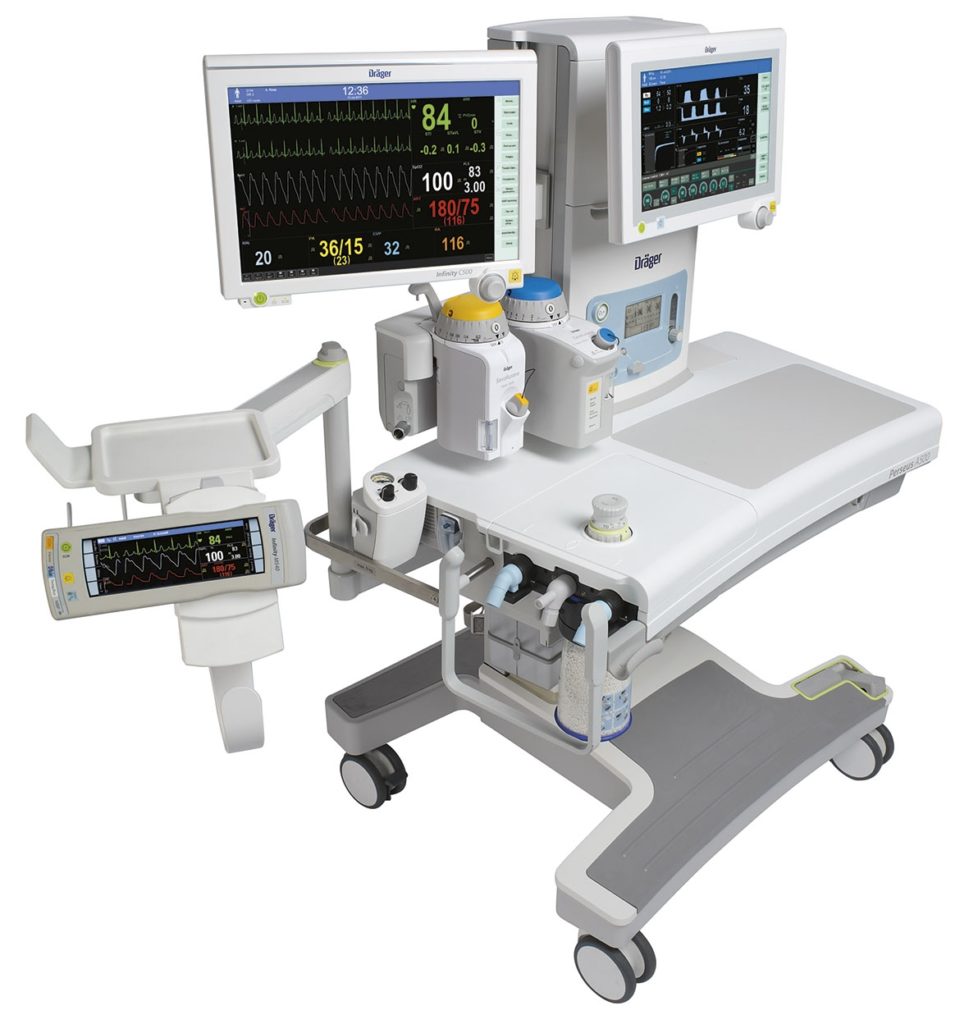
This German-made device is an anesthetic station and combines the latest developments in medical science and technology. The device is designed in such a way as to provide high-quality ventilation of the lungs in such a way that, with partial preservation of the respiratory function, it allows a person to breathe on his own.
Proprietary ventilation technology is designed in such a way as to quickly respond to changes in the concentration of the gas-air mixture in the respiratory tract.
Another feature of the Dräger Perseus station is the presence of a comfortable and spacious workplace, which includes an area for processing medical records, a cabinet for storing consumables, and an ergonomic arrangement of medical equipment control levers (brake pedal, buttons and switches). The design of the device is organized in such a way that its washing and disinfection does not require the use of special tools and devices.
In order to simplify the user interaction with the unit, it is equipped with a number of additional functions. Among them, we can distinguish the presence of self-diagnosis, the presence of a backup power source, which ensures the continuous operation of the device even during power outages. All shelves and consoles have universal fasteners, with which they can be positioned in such a way as to provide easy access. The control system is equipped with a rotary knob, so learning how to operate it is not difficult.
The built-in security system provides control of the concentration of gas-air composition in the respiratory tract, constantly assessing its parameters. There is a prediction function that allows you to focus not only on the experience of the doctor, but also on the data of the control system when setting up the characteristics, which together ensures the effective operation of the device.
Built-in intelligence warns in a timely manner about erroneous connection of hoses, and also informs about the timing of their replacement.The main screen of the device contains the following information: patient category and basic data about him, date, time, station name, information about its operating status, messages for the user, information about disabled alarms, as well as monitoring patient status parameters.
The unit has 2 additional screens that display various information, including gas composition and breathing volume, pressure in the mixture supply system. All monitors have good viewing angles. The device is equipped with a self-timer function. All wires and hoses are arranged in such a way as to prevent them from being tangled and to protect them from dust and other contaminants. The central brake and easily rotating wheels allow you to move the unit to any place and fix it with one push of a lever. The average price of the unit is 5,100,000 rubles.
- convenient access to all modules, it is possible to modify and configure the equipment for specific conditions;
- ergonomic workplace with lighting, a large number of shelves and cabinets for storing consumables;
- a large number of adjustments and settings for the operation of equipment;
- many positive user reviews;
- German quality of manufacturing materials and components.
- large dimensions;
- in Russia, a small number of specialists are able to set up and maintain the unit.
Dräger Fabius Plus
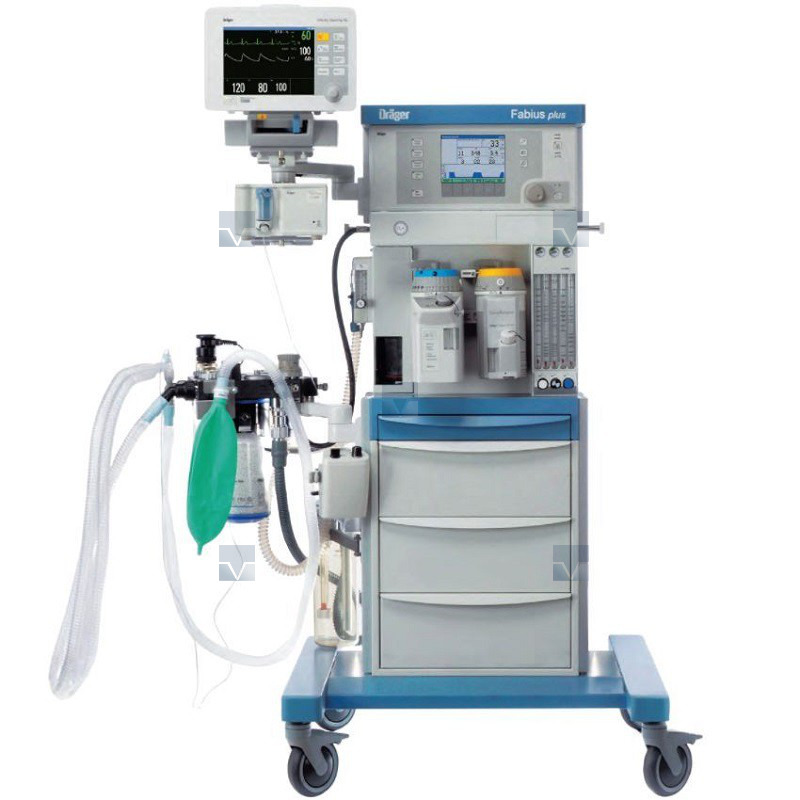
Another representative of one of the best German manufacturers, Dräger, is distinguished by high ventilation efficiency, simple operation, reliability and durability, and the possibility of configuring in various ways.
According to its intended purpose, the anesthetic-respiratory apparatus is an artificial lung ventilation device that does not require an external supply of liquefied gas. According to the manufacturer, the increased accuracy of the gas-air mixture supply allows the device to be used not only for adults, but also for children. Suitable for low flow anesthesia.
The mechanism can be additionally equipped with two evaporators. The modular design allows you to purchase and additionally install the required attachments, modifying the unit to the needs of a particular clinic. In addition to additional monitors, various sensors and controllers can be connected to the device, and the operating system allows you to integrate the device into the electronic system of the entire hospital without installing additional programs.
Upon request, the customer can choose options (for an additional fee) that are not included in the basic package when purchasing. These options include: fresh gas flow cut-off, backup ventilation, quick start (does not require power supply at the time of ventilation start), backup power supply, etc.
The unit is designed in such a way that it can be placed not only on the floor, but also hung on the wall, or installed on a mobile cart.
The screen can be either black and white or color (optional). Data on the patient's condition can be displayed both on monitors and in the general information system for their systematization, control and analysis. The average price is 1,944,000 rubles.
- you can install additional modules depending on the needs of the clinic;
- can be used for children and adults;
- universal mounts allow you to place the device not only on the floor, but also on walls, mobile carts;
- the unit is inexpensive at a price in its segment;
- a large set of programmable characteristics.
- low-functional device in the basic configuration.
Philips/Dameca Siesta I TS
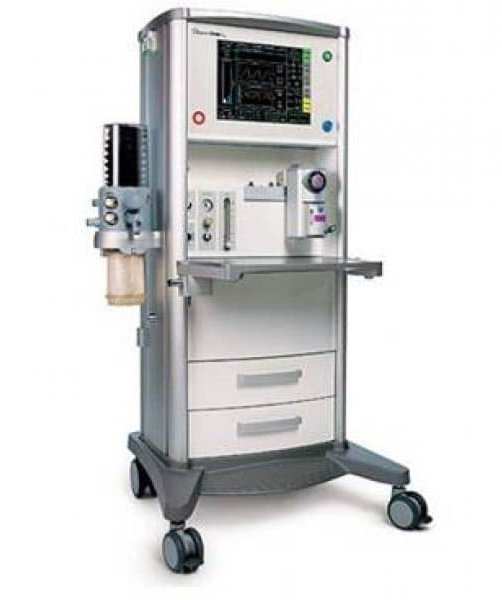
The American-made unit is well known among professional anesthesiologists. Its feature is the ability to use not only for adults, but also for children, including infants. NDA can be used as a ventilator, as well as for patients who have retained spontaneous breathing. The mechanism provides not only high-quality ventilation, but also displays the main vital signs of a person, allowing you to control his condition at the current moment.
In order to avoid the possibility of harm to human health, there is a built-in function to maintain the level of pure oxygen in the composition of the gas-air mixture of at least 25%. The mixture is removed from the respiratory tract using the active evacuation mechanism. To absorb carbon dioxide, a proprietary absorber is used, which can be disposable or reusable. The element can be replaced while the unit is running without interrupting the ventilation process. The unit can be used on low gases.
The 15” electronic display shows the following parameters: rotameter data (flow and percentage of oxygen), ventilation and respiration values, airway pressure graphs, alarms, etc. An optional gas monitor is installed, which makes it possible to control the percentage of oxygen and anesthetic, etc.
Tidal volume varies from 20 to 1500 ml.Breathing frequency - from 4 to 80 times per minute.
- suitable for children and adults;
- large informative display;
- a large number of additional settings and adjustments;
- quality materials and components.
- not budget cost;
- rarely found on sale, it is not always possible to order online in an online store.
Chirana Venar Omega
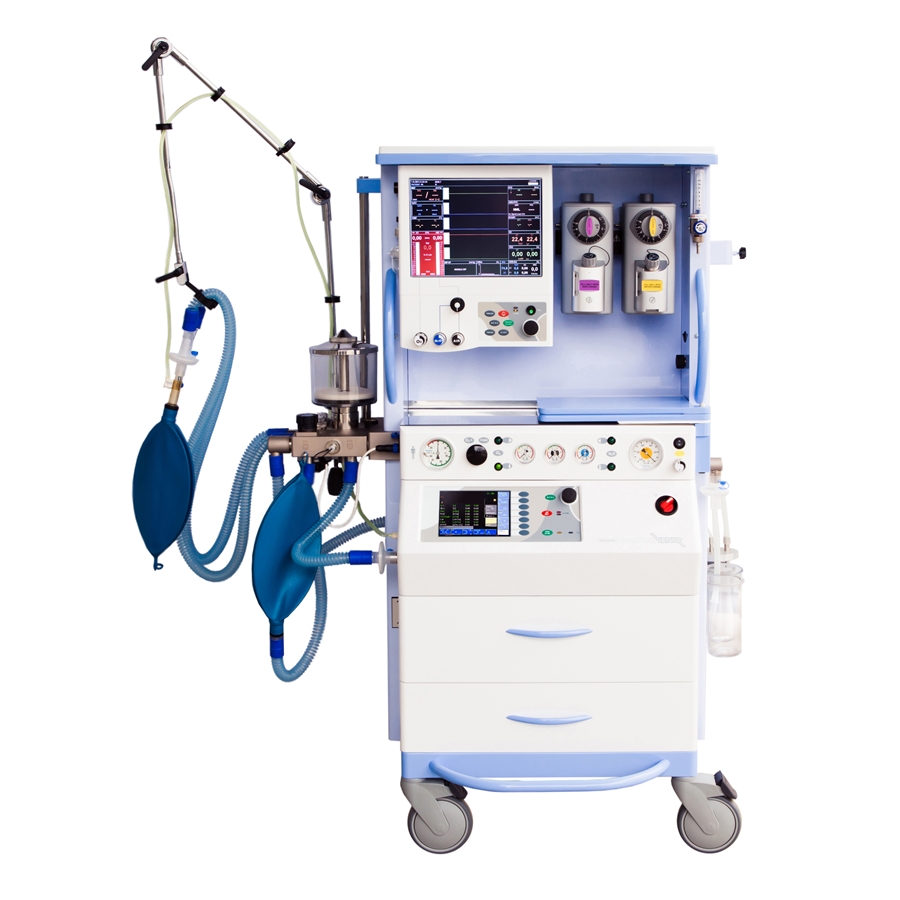
The Slovak-made device performed well in the field of anesthesiology. When making a choice, which company's device is better to buy, many professionals stop at this particular brand, since it combines an affordable price and a high-quality set of characteristics.
The device is a working anesthesia station. A monitoring unit is integrated into it, the main tasks of which are to monitor the supply of gases to the respiratory tract (rotameter function), as well as to control their functions. The unit is equipped with protection against electrical interference generated by medical devices. In order to make it convenient for the user to control the station, a 15-inch monitor is built into it, which displays all the main parameters of the patient's health status. The manufacturer offers to separately purchase a syringe dispenser station if necessary.
The tidal volume of the station varies from 5 to 1,500 ml, and a mount for two vaporizers is provided. There are eight ventilation modes, among the main ones are CMV, PCV, PS, MAN, SPONT, etc.
NDA monitors the following parameters: mechanical indicators of lung ventilation, graphical display of the current state of the respiratory tract, control of the volume of the spent gas-air mixture, quick adjustment of ventilation parameters.
Device Features:
- the presence of a three-level alarm system, incl.indication by light and sound;
- in order to start the basic mode - ventilation by volume - it is enough to enter only the patient's weight;
- intelligent control system eliminates the possibility of supplying a hypoxic air mixture;
- if for some reason the oxygen supply is stopped, the unit automatically starts to supply air from the environment into the lungs;
- there is a built-in uninterruptible power supply, with a period of operation of at least 2 hours.
Silent operation and high accuracy of setting the supply of the therapeutic composition makes it easier for the patient to be on the device. This is also facilitated by the electronic removal of the exhaled composition, the control of the percentage of oxygen, etc.
- wide functionality;
- built-in uninterruptible power supply;
- a large number of settings.
- small capacity of the built-in battery;
- according to buyers, the device is not durable and reliable.
General Electric Aespire 100/7100
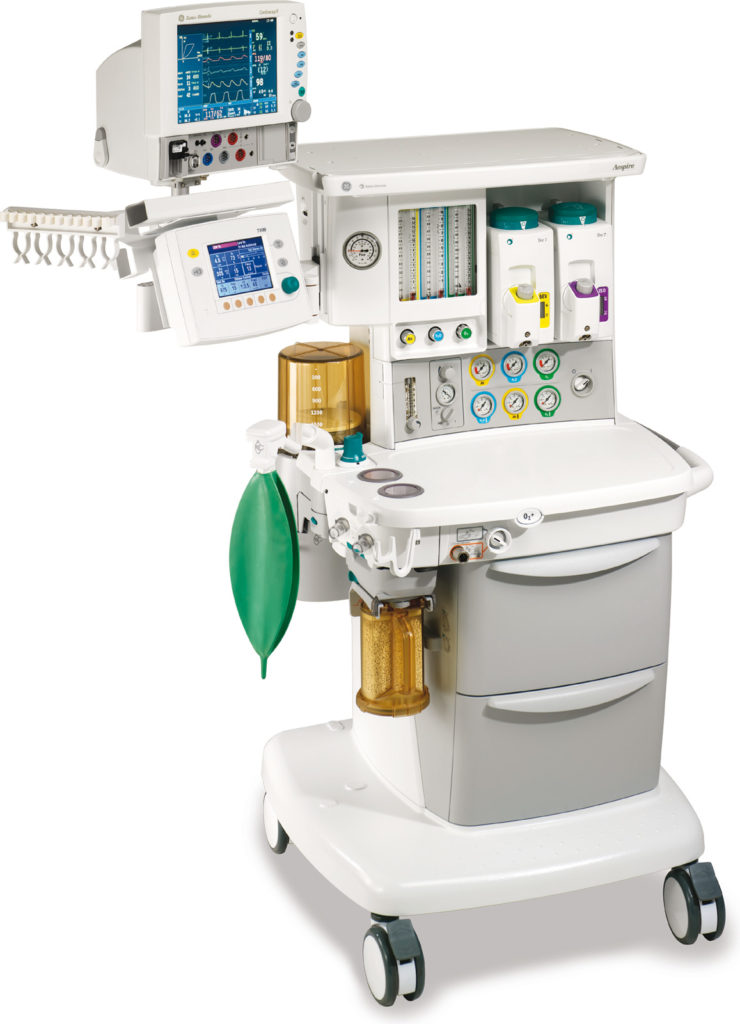
A Russian-made product is not as widely represented on the market as its counterparts, since it is a novelty. Nevertheless, during the period of operation, the equipment of this manufacturer has shown itself well, which allows us to recommend it for purchase.
Despite the compact dimensions of the device, it has a large work surface on which medical documents can be placed. Below the table there are two drawers in which you can store consumables and accessories. There is a built-in double backlight, all controls are located in such a way that the doctor can access them from a standing or sitting position.
The station comes with only one built-in monitor, but, if necessary, you can purchase and install an additional external screen that will display the main parameters of a person's condition.
Users note the ergonomic placement of the cables, so that they do not interfere with patient access and room cleaning. All connecting joints are made in such a way as to exclude accidental erroneous connection of cables to another socket. The station control system is designed in such a way as to automatically change the amount of gas in the mixture depending on its supply.
The interface is completely understandable even to an inexperienced user, there is an alarm system, monitoring the oxygen content in the patient's airways. Due to the special design of the bellows, the process of inflating them is visible to the user, and makes it possible to visually control the operation of the mechanism. The respiratory volume of the device is from 45 to 1,500 milliliters, the respiratory rate is from 4 to 65 breaths per minute.
- since this is a Russian-made unit, the buyer does not have any difficulties with where to buy it and see it “live”;
- in the delivery set there is an instruction with a detailed description of the NDA functionality, features of its use, tips and recommendations for care and maintenance;
- ergonomic workplace;
- high-quality plastic, resistant to chemicals;
- good functionality;
- budget price.
- not suitable for children.
Penlon Prima 450/460
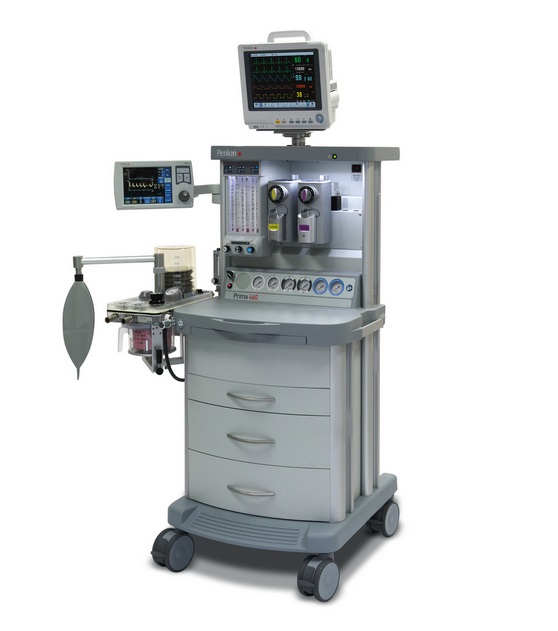
The British-made unit is rarely seen on the open market, but it also deserves attention.Compared to its competitors, the 450 has a compact footprint that allows it to fit into small rooms, treatment rooms and operating rooms. The 460th model has standard dimensions, it is possible to mount an additional third evaporator. Since both modifications have similar characteristics, we will consider them together.
Both modifications are made according to the latest standards in the field of world medicine, they can work with low and ultra-low gas flows. As in other high-quality devices of this type, there is protection against the entry of a hypoxic mixture into the patient's lungs. Both devices have six ventilation modes, there is a working area with built-in electrical outlets (equipped with lighting and a sliding table for documents). The 460 model allows the installation of up to three evaporators and up to 4 gas cylinders. Both models also have built-in spacious drawers for storing medical supplies.
The station has a built-in backup battery, with a duration of 30 minutes. The touch display shows all the necessary information and allows you to adjust the functions and adjust the settings with one touch. There is a special support for spontaneous inhalations and exhalations, which contributes to the rapid exit of a person to spontaneous breathing. You can save several individual user settings.
- a large set of built-in functions;
- ergonomic work area;
- model 450 has a compact size, which allows it to be placed in rooms with a small area, which are found in many Russian hospitals;
- suitable for adults and children.
- users complain about how much the station costs compared to competitors.
Portable models
VEGA-2-mini
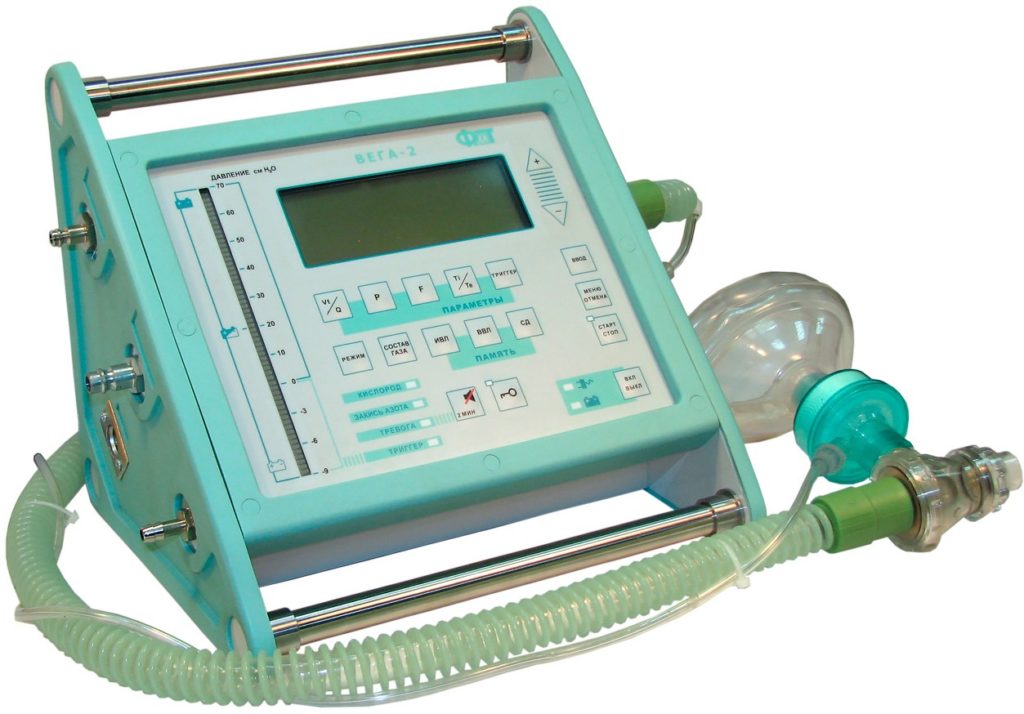
The portable NDA of the Russian plant FactorMedTekhnika LLC is widely used in ambulances, it is easy to carry due to its compact size and low weight (only 2.5 kilograms). It can also be used to help victims at the scene of an emergency, transport them to the hospital, or when moving between departments of the clinic.
There are three main functions - forced and assisted ventilation of the patient's lungs, spontaneous breathing. It is possible to adjust the ventilation mode by volume and pressure. Nitrous oxide can be supplied in all three modes.
The device can be used in adults and children aged 1 year and older. There is a foldable wall mount (most often used in ambulances).
Built-in memory allows you to store up to three custom ventilation modes, which are later turned on with the touch of a button. The battery lasts for 2 hours of battery life. The interface in Russian is designed in such a way as to simplify interaction with the device for the user - there are a large number of prompts, alarms, etc. If necessary, you can purchase a module that allows you to connect the NDA with the resuscitator.
- light weight;
- budget price;
- a clear interface allows even a non-specialist to figure out how to select the desired mode and what it is for;
- Compared with analogues made in China, it has a longer service life and better quality components.
- little functionality.
AINpSP-01/15-Medprom
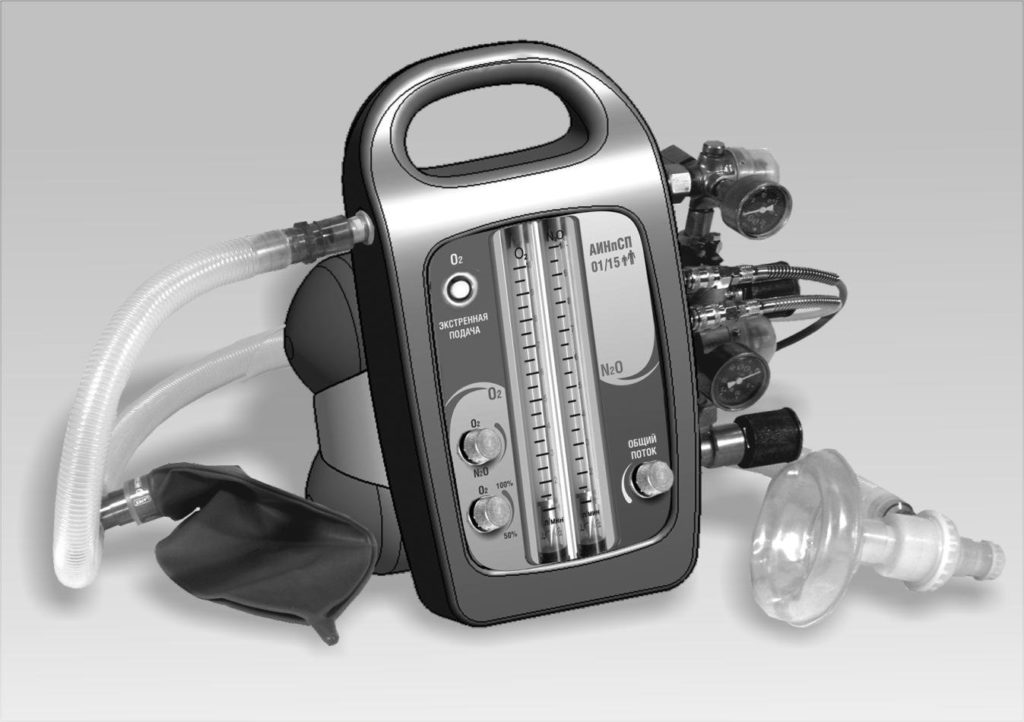
Another Russian-made unit, which is intended mainly for use in ambulances and in emergency situations. Can be used for adults and children aged 6 years and over.
NDA provides automatic supply of oxygen-air composition or a mixture of oxygen and nitrous oxide. Ventilation with pure oxygen is also possible. Compact dimensions and low weight (3 kg) allow using the device for emergency rescue activities. When the nitrous oxide supply is turned off, the oxygen supply is automatically stopped. The device can operate from its own cylinders with gas-air mixtures and nitrous oxide, or through an external connection.
- compact size and light weight;
- automatic pressure maintenance.
- can only be used for children over 6 years old;
- small capacity of the built-in battery.
AN-R10
This model is the most "simple" of all considered. It is intended for short-term pain relief and anesthesia, or as a manually operated ventilator. To supply oxygen or nitrous oxide, they use their own cylinders with a capacity of 1 liter, or stationary pneumatic systems located in reanimobiles or hospitals.
Despite the presence of manual pressure adjustment, there is an automatic control of maintaining it at a given level. To control the pressure in the cylinders, mechanical pressure gauges are used. When the nitrogen supply is interrupted, the oxygen supply is automatically shut off. There are two main modes - inhalation and anesthesia. The feed rate of the mixture of nitrous oxide and oxygen varies from 5 to 22 liters per minute.
- light weight and small overall dimensions;
- there are two built-in gas cylinders;
- There is an automatic pressure maintenance function.
- IVL requires manual control;
- short battery life.
Conclusion
It would be useful to mention that the selection and purchase of anesthesia and respiratory devices should be carried out by a person who has a good idea of what it is, what are the features of its use in a given situation, and also what are the significant differences between models of well-known world manufacturers.
Due to the fact that the market for such equipment is specific and the choice of devices is small, most often you have to choose from models of several well-known manufacturers. Unfortunately, only a private clinic can afford such an approach, since the state one is forced to be guided by the laws on public procurement, holding competitions, the main criteria for choosing the winner in which is the lowest cost. In this case, most often a Russian or Chinese manufacturer with equipment of not the best quality wins.
Currently, in a pandemic, there are certain difficulties with the supply of anesthesia equipment from abroad, which narrows the choice only to Russian devices, and not all the needs of clinics can be met. Probably, over time, the supply of NDA to Russia will be established, but perhaps by this time the urgent need for them may decrease.
We hope that our article will help you make the right choice!
new entries
Categories
Useful
Popular Articles
-

Top ranking of the best and cheapest scooters up to 50cc in 2022
Views: 131656 -

Rating of the best soundproofing materials for an apartment in 2022
Views: 127696 -

Rating of cheap analogues of expensive medicines for flu and colds for 2022
Views: 124524 -

The best men's sneakers in 2022
Views: 124041 -

The Best Complex Vitamins in 2022
Views: 121944 -

Top ranking of the best smartwatches 2022 - price-quality ratio
Views: 114983 -

The best paint for gray hair - top rating 2022
Views: 113400 -

Ranking of the best wood paints for interior work in 2022
Views: 110325 -

Rating of the best spinning reels in 2022
Views: 105333 -

Ranking of the best sex dolls for men for 2022
Views: 104372 -

Ranking of the best action cameras from China in 2022
Views: 102221 -

The most effective calcium preparations for adults and children in 2022
Views: 102015


